Eccentric 80s: Tabea Blumenschein, Hilka Nordhausen, Rabe perplexum, and Contemporary Accomplices
Lothringer 13 Halle
by Sophie Paul
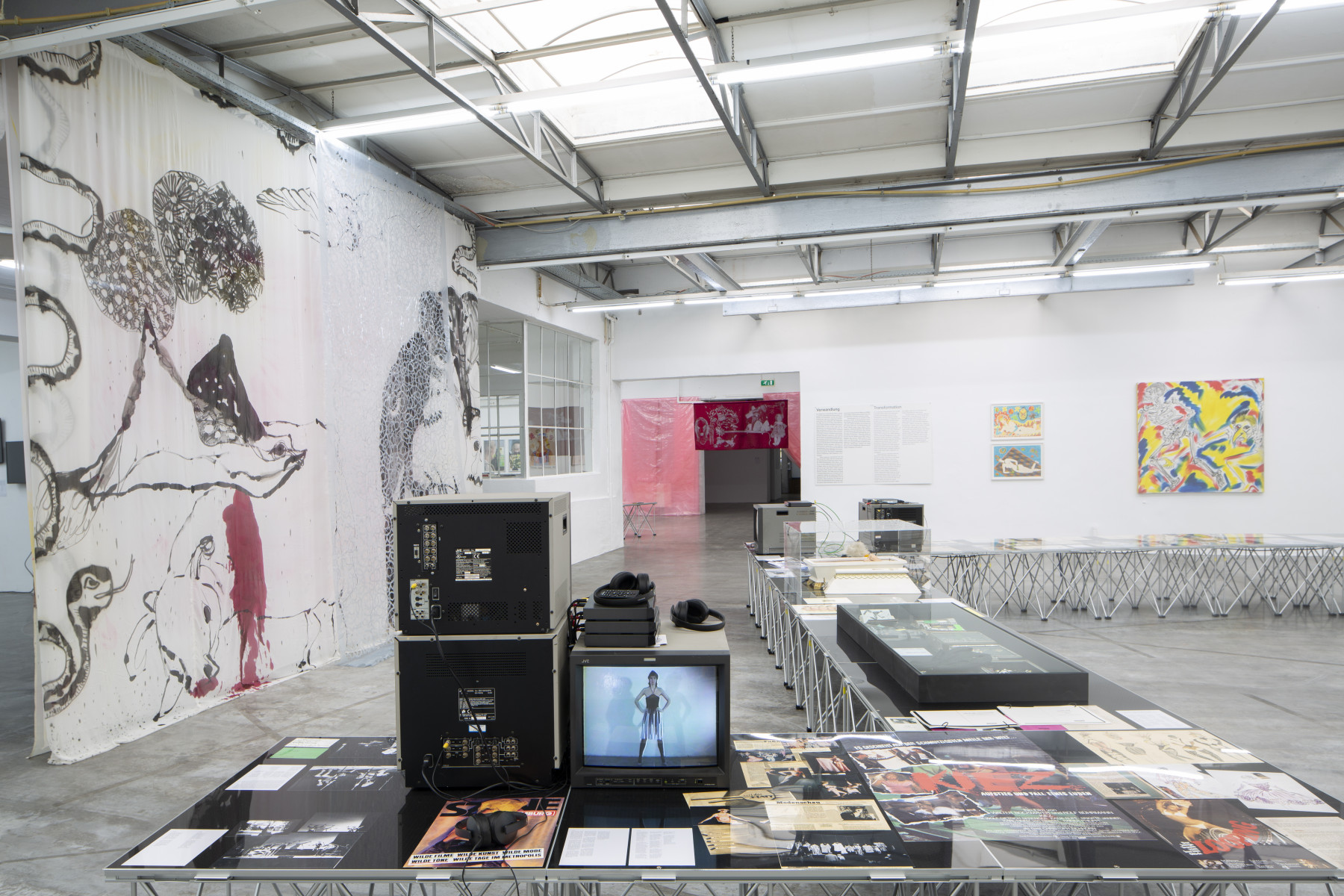
Eccentric 80s. Installation view. Lothringer 13 Halle, Munich. 2022. Photo by Constanza Meléndez.
A photograph of a woman sucking on a fish; a library; a morning star, and a raven. The eccentric – ex-centric, out-of-the-centre, weird, queer, deviant – offers a definitive moment of looking beyond. Eccentric ’80s at Lothringer 13 Halle in Munich tells a polyphonic history of 1980s West Germany through the practices of three artists, for whom the eccentric was a mode of refusal and solidarity. Each with a sub-cultural practice, we are pointed towards the eccentric as a set of actions, a materially-engaged mode of inhabitation. For those whose identities and artistic practices sit outside the normative script, eccentricism is less of an aesthetic and more a mode of being in-and-of the world. In the eccentric we find possibility through what is being concealed.
Eccentric ’80s is a contribution towards reviving the practices of Tabea Blumenschein, Hilka Nordhausen, and Rabe perplexum –– three artists active in Berlin, Hamburg, and Munich during the latter part of the 20th century. Much of Blumenschein, Nordhausen, and perplexum’s work remains relatively under-represented. Bringing their work to the fore now, is to recognise how their artistic practices were radically engaged with questions around identity and sexuality at a time that structurally suppressed these kinds of thoughts. Archival works by Blumenschein, Nordhausen, and perplexum are presented alongside contemporary responses from Ergül Cengiz, Philipp Gufler, and Angela Stiegler. Alongside art-historical input from Burcu Dogramaci and Mareike Schwarz, the show is a tangling together of history and the contemporary. I was lucky enough to exchange a few words with Gufler and their collaborators about Eccentric ’80s and the three years it spent in the making.
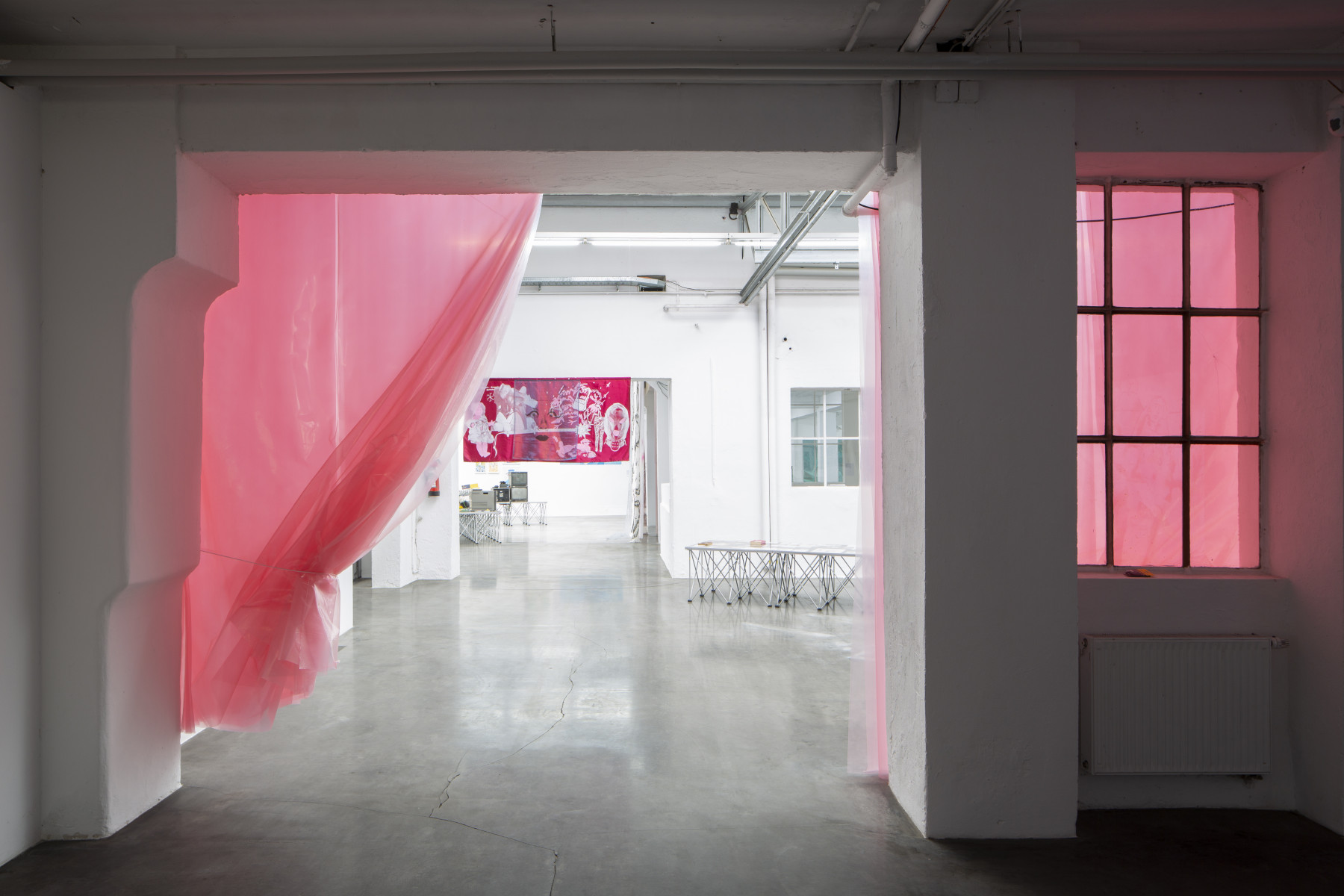
Eccentric 80s. Installation view. Lothringer 13 Halle, Munich. 2022. Photo by Constanza Meléndez.
Entering the main space at Lothringer 13 Halle involves stepping through a pink plastic curtain, slightly translucent like chewed bubblegum. On the other side, the exhibition is split between several open spaces that resemble both a gallery and an archive. Glass-topped tables snake around the space, presenting volumes of letters, posters, and photographs carefully lined up with corresponding labels. CRT televisions flicker on top of the tables, showing film documentation, and paintings smirk and holler on the walls. Things hang from the ceiling – costumes that look like campy ghosts in sparkled tutus, studded leather jackets, and fur coats. At first impression, the space straddles the look-and-don’t-touch of library-like restraint and provocative extravagance.
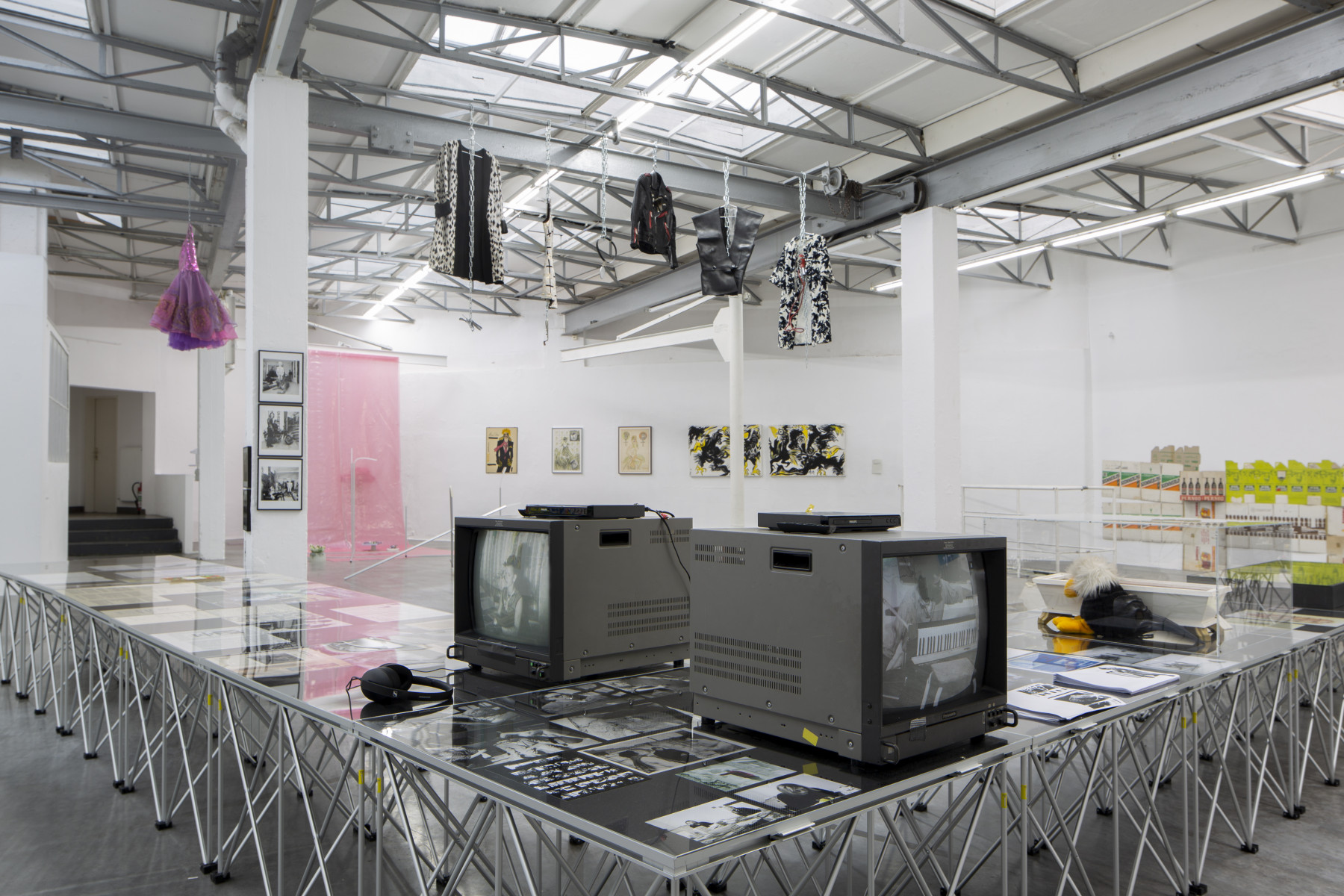
Eccentric 80s. Installation view. Lothringer 13 Halle, Munich. 2022. Photo by Constanza Meléndez.
There’s something interesting about situating this exhibition, honouring queer, non-institutional work within classic archival architecture. "Rabe exhibited a couple of times at Lothringer 13,” Gufler says in an email conversation, "so the context is very well fitting to their practice.” The research and curation of this show were self-organised by Cengiz, Gufler, Stiegler, Dogramaci and Schwarz, which feels a fitting way to represent the self-organised practices of Blumenschein, Nordhausen, and perplexum, and to prioritise the particularities of their practices as they were in the 1980’s — ex-centricised. In questioning the ways one can present art history, a dialogue is opened up between Blumenschein, Nordhausen, and perplexum, and the spaces their work occupies (or doesn’t) in the present day. Their lifetimes of work resist being funnelled into linear narratives – favouring instead fuller, more complex, fragmentary structures that in so doing, preserve their independence from the mainstream of the art world.

left: Hilka Nordhausen, untitl. [crocodile], 1980, cardboard, 13 parts, ARCHIV Hilka Nordhausen, Courtesy Holger Priess Galerie, right: Tabea Blumenschein, various paintings and drawings, dimensions variable. Eccentric 80s. Installation view. Lothringer 13 Halle, Munich. 2022. Photo by Constanza Meléndez.
Tabea Blumenschein was known as a performer and costume designer, though her space in the show is full of cartoonishly painted portraits. These portraits are garishly bright, tattooed, and transformative. Holding them next to some of Blumenschein’s quicker, smaller works on display provides a glimpse into a body of work invested in subculture and queerness. One undated pencil drawing, Mädchenzimmer – Girls Room, is depicted with almost confrontational intimacy and has the uneven, thick line work of a pencil pressed deep into the paper. Two girls are smirking, tattooed arms entangled, one with a cigarette dangling from her hand slung over the other’s shoulder. At almost every possible point, their bodies appear to touch. A postcard to the actress and artist Lil Picard, Für Lil, ‘Die Dollarprinzessin’ (For Lil, The Dollar Princess, 1977) shows Blumenschein in an ice-bath sucking on a fish. It is incandescently erotic. Implicit in Blumenschein’s figures is an expressive refusal of binary that feels contemporary. This carries across in Angela Stiegler’s poster series We Should All Be Bodys (2017), which has a similar visual language to Penny Goring’s posters, on display at the ICA in London this summer. We Should All Be Bodys collages images from a joint visit to the International Garden Exhibition at Berlin’s Gärten de Welt, with one word from the title printed consecutively on a poster in the series. One poster has the word ‘Bodys’ written on it in a lemony shade of chartreuse that could easily be found in a Blumenschein painting. The poster shows Blumenschein smiling, looking somewhat past us, with a cigarette dangling from her lips.
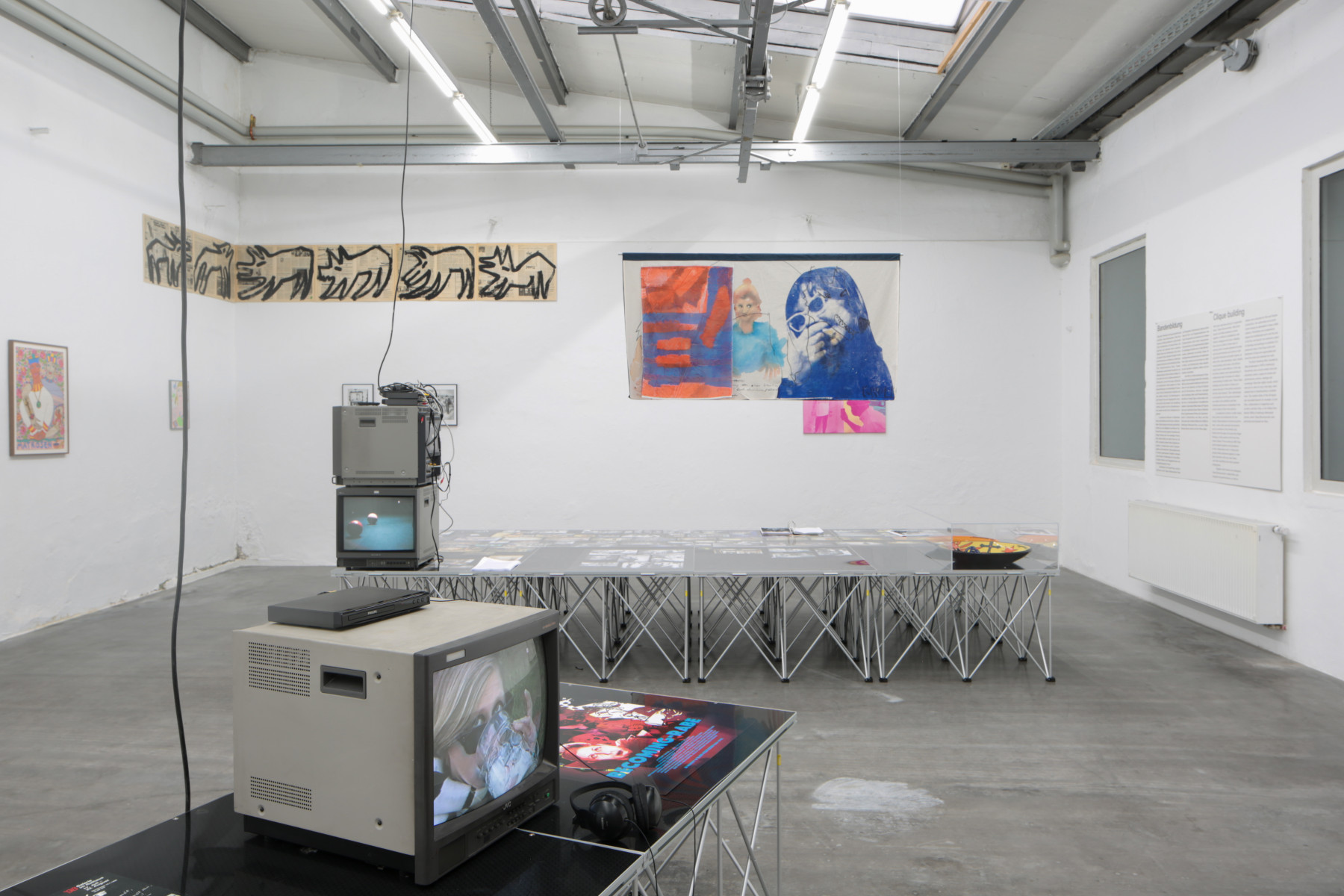
Eccentric 80s. Installation view. Lothringer 13 Halle, Munich. 2022. Photo by Constanza Meléndez.
Phillipp Gufler’s Quilt #49 (Hilka Nordhausen) (2022) is a double-sided screen-printed tribute to Nordhausen, made in collaboration with Burcu Dogramaci and 3 Hamburger Frauen. As well as a portrait of Nordhausen, it depicts her library and social-contact zone Buch Handlung Welt (Book Action World), which she ran in Hamburg between 1976 and 1983. Buch Handlung Welt was run in a non-commercial capacity, giving space for small runs of self-organised publications and zines, as well as readings, screenings, and short exhibitions. “The galleries were no place for our quick stuff,” Nordhausen had said, “we wanted to throw out the traditional marketing system and prove that we are autonomous.” [1] Amongst an ever-disintegrating commercial publishing world and social sphere, self-organised spaces such as Buch Handlung Welt, still, as they did in the 1980s, allow for collaborative working practices and the circulation of essential new knowledges. However, Gufler tells me, Buch Handlung Welt's 7 years were a constant financial turmoil: “These self-organised spaces need a lot of care and reproductive labour, which is still unfortunately often invisible and unpaid. It is important to not idealise the conditions under which artists run these spaces and find a way of working in solidarity to take care of each other.” Indeed, closing the space allowed Nordhausen to focus on her solo artistic practice. Nonetheless, in Buch Handlung Welt, we see what Nordhausen identified as ‘book action’ –– print and text-based practices that move beyond the page and into interdisciplinary conversations.
Rabe perplexum, the Raven, is characterised again and again in the space by exaggerated eyeliner wings and leather jackets that are irrevocably punk. Though to stop at punk would be a misgiving –– in a play with gender, their work dealt with questions about a non-binary identity that was unrecognised at the time. Implicit here, is an anthropomorphism that uses precarity as subject. Perplexum’s work was socially engaged, using public intervention and performance to highlight the vulnerable social positions of cultural workers –– Rathäusliche Supp-Ventions-Performance (1992) used funding from the Munich Department of Culture to open up a soup kitchen in the courtyard of Münchner Kulturreferat. Seemingly similar to other icons of the 20th-century such as Kathy Acker, they’re provocative and funny; their performances and interventions carry a subversive quality that implies a kind of self-dramatisation in the interest of queer visibility.
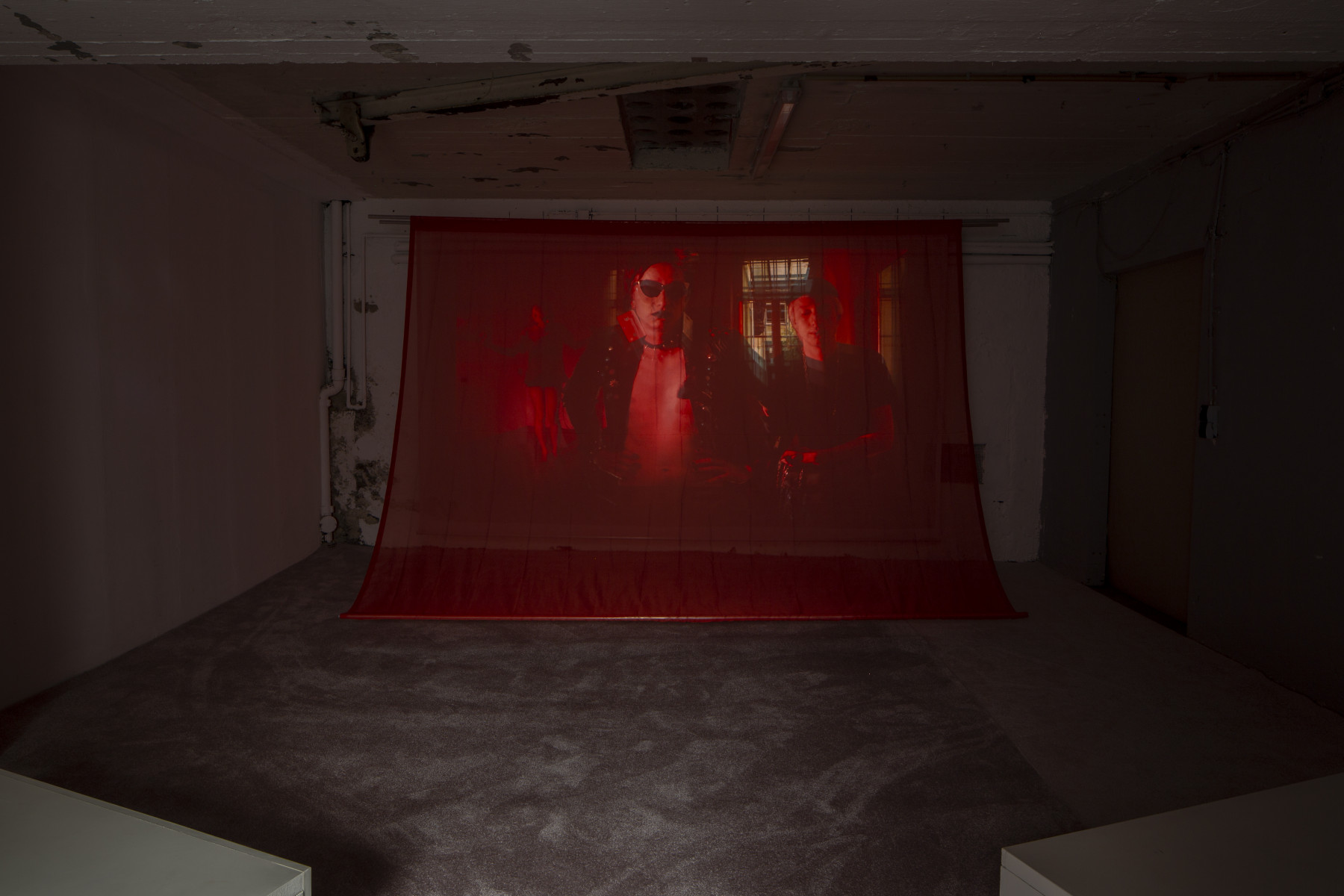
Philipp Gufler, Becoming Rabe (2016), video installation, 7:39 min. Co-Director and Director of Photography: Narges Kalhor. Sound and Music: Colin Djukic. Text: Philipp Gufler and Rabe Perplexum. With original footage from "The Unknown Artist" and "Aus Not Geld Fressen" by Rabe Perplexum. Costumes by Rabe Perplexum. Eccentric 80s. Installation view. Lothringer 13 Halle, Munich. 2022. Photo by Constanza Meléndez.
Gufler’s Quilt #08 (Rabe perplexum) (2015) is a visual archive of its own, reproducing objects from perplexum’s oeuvre. A gimp mask, a baby doll, and a morning star accompany a portrait of perplexum which is layered over the top on sheer fabric. Gufler’s film Becoming Rabe (2016), screened in the dark basement space, is a transformation into perplexum as Gufler takes on the qualities of the Raven. Both works present an affront to the limitations of binary identity, a mirroring through which the boundaries of identity between perplexum and Gufler are blurred. A subtitle from Becoming Rabe reads “mirror the Rabe, who only comes alive through your inspection.” [2] In both of the works, perplexum stares out at us, mimicking our own scrutiny.
What does the work of Blumenschein, Nordhausen, and perplexum signify in 2022, at a moment when queerness has become much more marketable from within the institution? We’re now in a moment where Pride events draw mass sponsorship and arguably empty symbolism from companies and commercial entities, which does little for the advancement of queer peoples' actual lives. Each of these artists was ex-centricised, with a practice that stood for a certain kind of freedom whilst their means of survival were restrained and their identities marginalised. “I’m interested in the discourse around queerness,” Gufler reflects, “as it allows a concept of more fragile and fluid identity categories. Inherent in their [Blumenschein, Nordhausen, and perplexum’s] self-description was a certain refusal to label themselves in a marketable way. The current tendency to use queer only as an umbrella term for LGBTI+ people (which is easily marketable) without the historical knowledge about the legacy of the word does not fully correspond to their way of living and being.” Blumenschein, Nordhausen, and perplexum all identified and worked artistically in ways that removed themselves, or were removed, from the normative script. Their histories point towards complexity, grit, and the necessity of self-organisation in queer subcultural practice. A much-needed and celebratory contribution to the field of queer art history, Eccentric 80s takes a step towards visibility, recognition, and liberation, which has just as much to do with looking back as with looking forward.
[1] Hilka Nordhausen, My attack on reality, ‘BOOK STORY WELT’ (Berlin, 1990) www.hilkanordhausen.de/index-q=node-60 Accessed 21/11/2022.
[2] Phillipp Gufler, Becoming Rabe (excerpt) (2016) https://vimeo.com/300765189 Accessed 22/11/2022
Eccentric 80s: Tabea Blumenschein, Hilka Nordhausen, Rabe perplexum, and Contemporary Accomplices.
With works by Ergül Cengiz, Philipp Gufler, and Angela Stiegler
Lothringer 13 Halle
Lothringer Str. 13
81667 München
9/9—6/11/2022
Kunstverein Tiergarten
Turmstraße 75
10551 Berlin
14/12/2022 – 04/02/2023
Kunsthaus Hamburg
Klosterwall 15
20095 Hamburg
25/03/2023 – 21/05/2023
With thanks to Ergül Cengiz, Philipp Gufler, Angela Stiegler, Burcu Dogramaci and Mareike Schwarz for their input and illuminations.